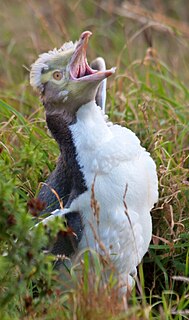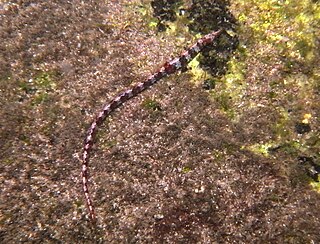
The Australian pied cormorant, also known as the pied cormorant, pied shag, or great pied cormorant, is a medium-sized member of the cormorant family. It is found around the coasts of Australasia. In New Zealand, it is usually known either as the pied shag or by its Māori name of kāruhiruhi. Older sources may refer to it as the "yellow-faced cormorant".

The yellow-eyed penguin, known also as hoiho or tarakaka, is a species of penguin endemic to New Zealand.

The erect-crested penguin is a penguin endemic to the New Zealand region and only breeds on the Bounty and Antipodes Islands. It has black upper parts, white underparts and a yellow eye stripe and crest. It spends the winter at sea and little is known about its biology and breeding habits. Populations are believed to have declined during the last few decades of the twentieth century, and the International Union for Conservation of Nature has listed it as being "endangered".

The Snares penguin, also known as the Snares crested penguin and the Snares Islands penguin, is a penguin from New Zealand. The species breeds on the Snares Islands, a group of islands off the southern coast of the South Island. It is a yellow-crested penguin, with a size of 50–70 cm (19.5–27.5 in) and a weight of 2.5–4 kg (5.5–8.8 lb). It has dark blue-black upper parts and white underparts. It has a bright yellow eyebrow-stripe which extends over the eye to form a drooping, bushy crest. It has bare pink skin at the base of its large red-brown bill.

Megadyptes is a genus of penguin from New Zealand.

The rockhopper penguins are three closely related taxa of crested penguins that have been traditionally treated as a single species and are sometimes split into three species.
The Waitaha penguin is an extinct species of New Zealand penguin described in 2009.

Nototodarus sloanii is a species of squid commonly known as the New Zealand arrow squid or Wellington flying squid. It is also known by its Māori name of wheketere. It is a favoured prey species of a number of marine mammals and diving birds. It is an important food source for the New Zealand fur seal and two endangered species: the New Zealand sea lion and the yellow-eyed penguin. N. sloanii is sought by trawler fishermen for human consumption; New Zealand sea lions are frequently caught in trawl nets and drowned when feeding on N. sloanii.

The eastern rockhopper penguin is a crested penguin with yellow crest feathers. It is a subspecies of the southern rockhopper penguin found in subantarctic regions and the Indian Ocean. It is one of the smallest crested penguins and has distinctive pink margins around its bill.

Lissocampus is a genus of pipefishes mostly native to the Indian Ocean. One species (L. bannwarthi) is only known to occur in the Gulf of Aqaba and the Gulf of Suez and one species (L. filum) occurs in the Pacific Ocean around New Zealand and the Chatham Islands. The remaining species are endemic to Australia.
Lissocampus bannwarthi is a species of marine pipefish belonging to the family Syngnathidae.

Lissocampus caudalis, also called the Australian smooth pipefish or the smooth pipefish, is a species of marine fish belonging to the family Sygnathidae.
Lissocampus fatiloquus, also known as prophet's pipefish is a species of marine fish belonging to the family Syngnathidae. The species has been noted in a variety of habitats including sargassum, seagrass beds and sandy substrates along the coast of Western Australia from Shark Bay to Rottnest Island. Their diet is thought to consist of small crustaceans such as copepods. Reproduction occurs through ovoviviparity in which the males brood eggs before giving live birth.

Lissocampus runa, also known as the javelin pipefish is a species of marine fish belonging to the family Syngnathidae. This species can be found in algae beds, rocky reefs, tidepools, and estuaries along the coast of southern Australia from Broken Head Nature Reserve in New South Wales to Rottnest Island, Western Australia. Their diet is thought to consist of small crustaceans such as copepods. Reproduction occurs through ovoviviparity in which the males brood eggs before giving live birth.
Phoxocampus tetrophthalmus, also known as the trunk-barred pipefish is a species of marine fish belonging to the family Syngnathidae. This species can be found in reefs and tide pools of the Indo-Pacific specifically Indonesia, the Philippines, and Guam. They have also been observed in the Andaman, Cocos-Keeling, and Ryukyu islands. Their diet likely consists of small crustaceans Reproduction occurs through ovoviviparity in which the males brood eggs before giving live birth.
Stigmatopora nigra, also known as the wide-bodied pipefish is a species of marine fish belonging to the family Syngnathidae. This species can be found in the shallow waters, bays, and estuaries of southern Australia from Shark Bay to Brisbane, Tasmania, and New Zealand. They often inhabit seagrass or algae beds in addition to bare sand. Their diet consists of small crustaceans such as copepods and amphipods. Adult brooding males have been measured at 6.5-7 centimeters. Reproduction occurs through ovoviviparity. in which the males brood up to 25 eggs in a pouch below the tail before giving live birth. Stigmatopora nigra can live to 150 days old and are able to reproduce throughout the year.
Urocampus carinirostris, also known as the hairy pipefish, is a species of marine fish belonging to the family Syngnathidae. They can be found inhabiting shallow seagrass beds and estuaries in Papua New Guinea and along the southern coast of Australia from Queensland to Swan River, Western Australia. Urocampus carinirostris is an ambush predator that is most commonly found on the edges of protected seagrass beds and near mangrove. Its diet consists of copepods and other small crustaceans. Reproduction occurs through ovoviviparity in which males brood around 48 eggs in a pouch beneath their tail before giving live birth to fully formed offspring. Adults can breed for at least six months.
Pseudophallus mindii, also known as the freshwater pipefish is a species of marine fish belonging to the family Syngnathidae. They can be found in freshwater coastal rivers and mangrove estuaries ranging from Belize to Brazil. Members of this species can grow to lengths of 16 cm and their diet likely consists of small crustaceans. Reproduction occurs through ovoviviparity in which the males brood eggs before giving live birth.
Nannocampus pictus, also known as the reef pipefish is a species of marine fish belonging to the family Syngnathidae. They can be found inhabiting reefs and seagrass beds of the western Indian Ocean and the eastern coast of Australia including the Great Barrier Reef. Members of this species can grow to lengths of 10 cm and their diet likely consists of small crustaceans such as copepods. Reproduction occurs through ovoviviparity in which the males brood eggs before giving live birth.
Nannocampus subosseus, also known as the bony-headed pipefish is a species of marine fish belonging to the family Syngnathidae. They can be found inhabiting reefs and tide pools only in the region of Shark Bay to Esperance, Western Australia. Members of this species can grow to lengths of 12 cm and their diet likely consists of small crustaceans such as copepods. Reproduction occurs through ovoviviparity in which the males brood eggs before giving live birth.













